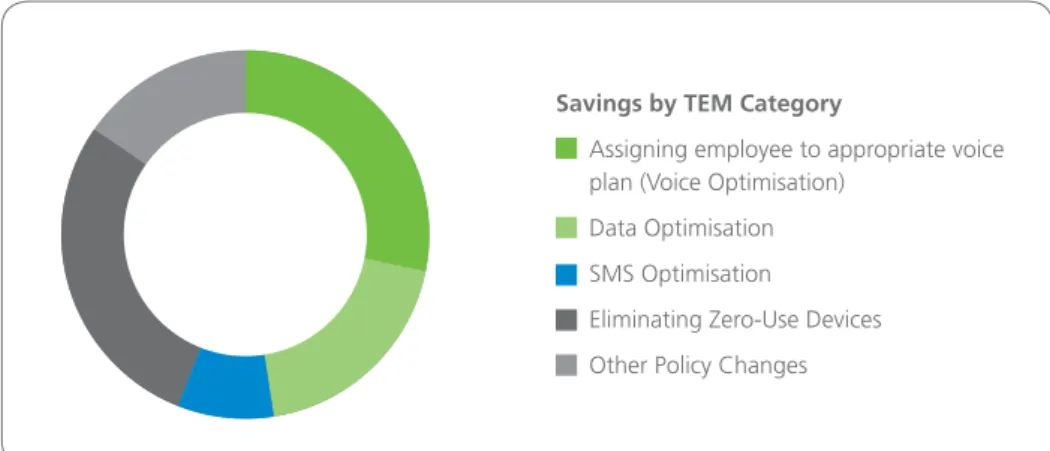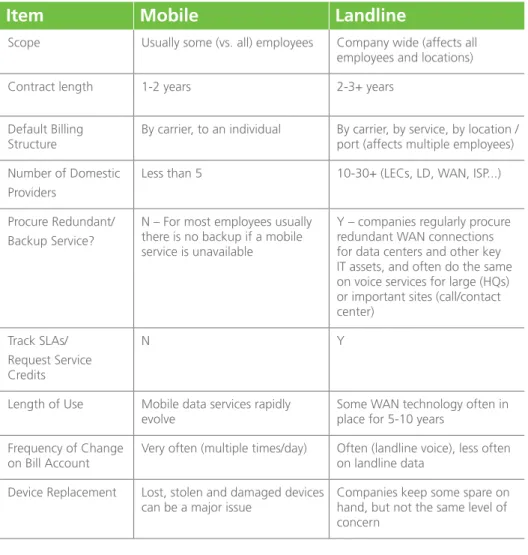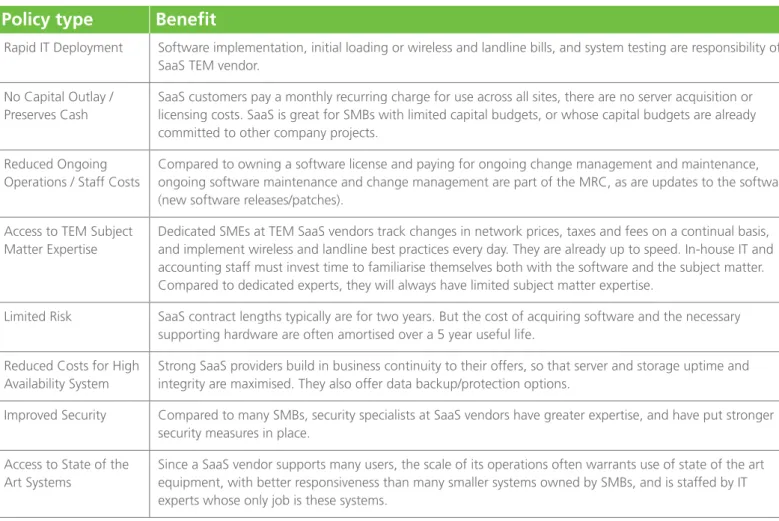Four Best Practices to
Maximise the Benefits of
Telecom Expense Management
A strategic change in future business
direction forced ENERDEV, a
medium-sized energy development
company, to aggressively reduce
costs and implement processes to
tighten controls over operations on
a going-forward basis. One action
the company took was to implement
a scalable, low lifetime TCO
SaaS-based telecommunications expense
management (TEM) solution across
both landline and mobile services. As
a result of implementing sound TEM
practices and modifying key ongoing
managerial, financial and IT business
processes, ENERDEV is saving over
$1.9M on its overall annual domestic
telecom budget – 21% on landline,
and 24% on mobile services. In
ENERDEV’s case, every dollar it cuts
from its operating budget equates
to $3 of new top-line growth – each
and every year.
The energy development company in this case study, who we’ll call ‘EnerDev’, has a market cap of $30B. It made a strategic decision to focus its business around certain core competencies. After a thorough analysis, it divested the business operations it deemed outside the company’s long-term direction, resulting in a 40% decline in annual operating revenues. It began divesting these operations in 2009. Taking such bold action during a major recession took great foresight and leadership, but management anticipates these decisions and related actions will propel future earnings growth to heights competitors can’t easily duplicate.
When considering the company’s going-forward business and network, over 93% of its 75 domestic sites are located in very rural areas across 6 states. Although ENERDEV’s IT/network department had acquired the appropriate voice and data services to serve all of 5000 domestic employees, financial oversight hadn’t been centralised – each site was responsible for its telecom bills. As a result, ENERDEV lacked complete, company wide data on some of the most basic information – including network inventory, service utilisation and trends, and total spend. This impeded the ability of ENERDEV’s Finance and IT/network departments to collaborate on planning and implementing the necessary steps to help the company during its difficult business transition, and after emerging, to continue to operate in a prudent fashion. After ENERDEV put the appropriate telecommunications expense management (TEM) practices and controls into place, it found a number of ways to improve the performance of its network assets not only a one-time basis, but on a compounding basis. As a result, ENERDEV’s ongoing landline and mobile network budget now is about the size of its former landline (only) budget.
Key best practices
ENERDEV’s experience provides insight into four key lessons that many businesses can and should apply:
Ongoing collaboration is the new
modus operandi
As discussed above, prior to the company’s decision to downsize, the offices of the CFO and CIO, and their departments, worked together on an infrequent basis usually when going out to RFP for an significant IT or network asset/service, or when planning and reviewing budgets. But strong business practices and systems that weave finance and network disciplines seamlessly together are collaborative and continual in nature – the TEM system provides the appropriate level of detail/summarisation to all parties in all departments on every bill that comes in (no matter its size), every device that is activated or deactivated, every network contract signed, and every technology decision. To reach the company’s goals, ENERDEV embraced this necessary cultural change. Today, the CIO’s office is fully aware of the budgetary impact of adding or disconnecting a port or service, and the CFO’s office reviews technology usage trends on a frequent basis, and now proactively works with the CIO to plan upgrades in a manner that optimally impacts field and management operations. Field operations has access to all the services and devices it needs on a timely basis, and uses the TEM process to notify all interested parties of changes that impact network usage and budgets, like inter-departmental transfers, new hires and terminations. For all departments, unpleasant ‘surprises’ are a thing of the past.
Apply TEM to all network assets
and services
Many companies ask TEM suppliers for help with problems they consider to be particularly vexing. As a result, they often focus exclusively on mobility because company use of mobile devices and services has grown so quickly, and control of mobile expenses has been neglected for so long. This certainly was the case with ENERDEV, and by appropriately applying sound mobile TEM management practices on an ongoing basis, it now saves 24% each and every month (see Figure 1).
Use a single-platform,
multi-service, multi-provider
TEM solution
Since ENERDEV was adopting a centralised approach to managing both the technical and financial elements of its networks, the most appropriate TEM solution provided it with a single view of wireless inventory, usage/bills and trends across all domestic carriers and services (mobile text, data and voice). ENERDEV uses the multicarrier mobile services and device catalog and ordering processes that the TEM provider customised for its requirements. Although each mobile provider’s interfaces and processes are unique, the TEM provider masks all that – ENERDEV uses one common interface and tool. Similarly, ENERDEV uses a single multi-service, multi-provider interface and tool across all of its landline voice and data services and providers. Since the TEM provider uses the same software, supported by a common developer team, to support both landline and mobile applications, ENERDEV is able to obtain a total view across all its services and providers. By using a single software platform, the TEM vendor can quickly and cost-effectively customise the same type of report for both mobile and landline services, and for multiple carriers. The TEM platform ENERDEV uses is highly flexible – one can aggregate users, usage and inventory in a traditional fashion- for instance, hierarchically by department, division, region, etc. all the way up to the CEO. Alternatively, ENERDEV can group users, devices, services and usage by project (or other task-centric category).
Use a SaaS-based TEM solution
Compared to a completely outsourced model, or one with a high software licensing cost and a potentially long implementation window, this provides ENERDEV with state-of-the-art TEM functions on a highly secure, scalable, reliable infrastructure with a low lifetime TCO (see Table 3). The SaaSbased TEM approach ENERDEV selected also: But ENERDEV was prudent to realise thatmobile and landline networks are very different, and they need strong subject matter expertise and management processes on both types of network services to maximise ongoing benefits (see Table 1 and Table 2). Since 86% of every network services dollar ENERDEV spends is on landline, it also implemented a variety of ongoing landline-specific voice and data TEM practices. As a result, ENERDEV saves 21% each and every month on landline. Eight-five cents out of every dollar ENERDEV now saves via TEM is savings on landline expenses (see Figure 2).
Figure 1: XYZ TEM Savings: 24% of Budget
Figure 2: Sources of landline TEM Savings at XYZ
Savings by TEM Category
Assigning employee to appropriate voice plan (Voice Optimisation)
Data Optimisation SMS Optimisation
Eliminating Zero-Use Devices Other Policy Changes
Confirmed Savings by TEM Activity ($855,500/year)
Access Connection Overcharge Casual vs. Contracted Billing Rate Apply Correct Contract Discount Disconnect Service/Bill
CRAM
Contract Price Not Applied Other
• Embraced the dynamic nature of ENERDEV’s business and network requirements. Although a huge, one-time event served as the catalyst for ENERDEV to begin using TEM tools and practices, the company was quick to appreciate that change in business is a constant. Employees and contractors come and go all the time, new ventures and acquisitions are continually being evaluated. As a result, a static, audit-based approach to TEM could not possibly serve ENERDEV’s interest (this type of approach is often used by sourcing specialists). Neither could one where the creation of new reports or analyses required substantial developer lead time, as can be the case when using a traditional software license. Like many other companies, ENERDEV needed a flexible approach that could quickly, cost effectively adapt and change in lock-step with its business direction, and with the rapidly changing world of telecommunications. For example, ENERDEV is evaluating migrating WAN access to its data centers from MPLS to Ethernet services, and is interested in using LTE in the near future. It has operations in Canada and other parts of the world, and the TEM solution is chose supports all of those providers’ landline and mobile voice and data services, ordering and billing platforms, and evolving regulatory requirements. Finally, the platform easily scales with the company’s changing size – since the time ENERDEV downsized, the number of employees with mobile devices has grown by over 100%, and ENERDEV’s TEM solution adapted seamlessly.
• Provided ENERDEV with high quality subject matter expertise. Since ENERDEV uses one of the nation’s leading multitenant SaaS-based providers, it has access to TEM subject matter specialists – professionals who serve multiple companies that possess deep expertise on the network technologies, carrier billing practices and foibles, who have at their fingertips access to updates on taxes and fees, which account for more than 11% of carrier bills. Despite ENERDEV’s large network budget, it never employed these types of professionals on a regular basis. Now, like many mid-size and smaller companies, ENERDEV enjoys the full range of benefits a state-of-the art TEMbased solution provides.
Item
Mobile
Landline
Scope Usually some (vs. all) employees Company wide (affects all employees and locations)
Contract length 1-2 years 2-3+ years
Default Billing
Structure By carrier, to an individual By carrier, by service, by location / port (affects multiple employees) Number of Domestic
Providers
Less than 5 10-30+ (LECs, LD, WAN, ISP...) Procure Redundant/
Backup Service?
N – For most employees usually there is no backup if a mobile service is unavailable
Y – companies regularly procure redundant WAN connections for data centers and other key IT assets, and often do the same on voice services for large (HQs) or important sites (call/contact center)
Track SLAs/ Request Service Credits
N Y
Length of Use Mobile data services rapidly
evolve Some WAN technology often in place for 5-10 years Frequency of Change
on Bill Account Very often (multiple times/day) Often (landline voice), less often on landline data Device Replacement Lost, stolen and damaged devices
can be a major issue Companies keep some spare on hand, but not the same level of concern
Table 1: Important Differences in Managing Mobile and Landline Service
Like many other companies, ENERDEV
needed a
flexible approach
that could
quickly
,
cost effectively adapt
and change
in lock-step with its business direction,
and with the rapidly changing world of
telecommunications.
Policy type
Benefit
Entitlement TEM supplier worked with a new department at XYZ to specify job functions and align them with appropriate mobile recourses. XYZ developed guidelines for appropriate consumption of voice, text and data. Every employee is assigned a profile comprised of types of mobile services, usage plans, devices, features and accessories.
XYZ uses TEM portal’s automated reporting tools to identify employees whose mobile service usage or device choice is outside of established parameters, but departmental managers make the final call and are ultimately responsible for their group’s mobile budget, employee discipline, etc.
Device Standardisation Identification of important job tasks helps XYZ identify the types of devices, and the makes and models, that are most appropriate for each category of user. As a result, only these devices are loaded into XYZ’s mobile online device catalog (typically updated 2-4x/year).
Since device make/model choice is limited, it helps to reduce in-house helpdesk support costs (XYZ operates its own mobile help desk), and costs to update the online catalog.
Appropriate Use TEM supplier and XYZ work together to establish (and periodically review) guidelines for appropriate use of wireless services by job category.
Examples include downloading of personal content via aircards, ability to make/receive international calls on mobile phones, purchase of/thresholds on optical mobile carrier features/services like games and ringtones.
Manager Visibility Use of TEM portal to run recurring and exception-based reports make it easy for supervisors and
administrators to identify employees whose use of mobile resources is out-of-bounds. Employees often change their behaviour once they are aware that management is (now) paying attention.
Once the oversight tools are in place and the information is appropriately disseminated, employee consumption of mobile services typically decreases by 8-14%.
Table 2: Examples of Mobile TEM Policies and Benefits at XYZ
Table 3: Advantages of SaaS-based TEM Model
Policy type
Benefit
Rapid IT Deployment Software implementation, initial loading or wireless and landline bills, and system testing are responsibility of SaaS TEM vendor.
No Capital Outlay / Preserves Cash
SaaS customers pay a monthly recurring charge for use across all sites, there are no server acquisition or licensing costs. SaaS is great for SMBs with limited capital budgets, or whose capital budgets are already committed to other company projects.
Reduced Ongoing Operations / Staff Costs
Compared to owning a software license and paying for ongoing change management and maintenance, ongoing software maintenance and change management are part of the MRC, as are updates to the software (new software releases/patches).
Access to TEM Subject Matter Expertise
Dedicated SMEs at TEM SaaS vendors track changes in network prices, taxes and fees on a continual basis, and implement wireless and landline best practices every day. They are already up to speed. In-house IT and accounting staff must invest time to familiarise themselves both with the software and the subject matter. Compared to dedicated experts, they will always have limited subject matter expertise.
Limited Risk SaaS contract lengths typically are for two years. But the cost of acquiring software and the necessary supporting hardware are often amortised over a 5 year useful life.
Reduced Costs for High Availability System
Strong SaaS providers build in business continuity to their offers, so that server and storage uptime and integrity are maximised. They also offer data backup/protection options.
Improved Security Compared to many SMBs, security specialists at SaaS vendors have greater expertise, and have put stronger security measures in place.
Access to State of the Art Systems
Since a SaaS vendor supports many users, the scale of its operations often warrants use of state of the art equipment, with better responsiveness than many smaller systems owned by SMBs, and is staffed by IT experts whose only job is these systems.
CS / AAA-0000 / 02/12 © Copyright Dimension Data 2012
Conclusion
An important reason that ENERDEV successfully navigated through the divestiture of 40% of its business is the willingness of management to objectively review the performance of all departments, and to identify and embrace necessary change to reach its new and future business objectives. Given the aggressive financial targets senior management established for the IT and network departments, ENERDEV quickly implemented important landline and mobile TEM practices across all US locations at the same time, and employed a highly scalable, flexible multi-tenant SaaS solution to implement these practices in a highly expeditious, cost-effective manner. Since key departments and functions now work cooperatively on a continual basis, ENERDEV successfully transformed important elements of its culture, a change that will continue to yield benefits on a going forward basis.
About the author
Lisa Pierce is the founder of Strategic Networks Group. She is an expert on emerging business class network services, including telco-cloud, SIP Trunking, UC/ VOIP, FMC, MPLS, Ethernet, and 4G. A frequent speaker and media commentator, she has authored and published more than 800 reports. Her professional background includes more than 10 years as Vice President of Telecommunications Research at Forrester Research, four years in telecommunications protocol consulting and training for a boutique consultancy, and nine years at AT&T in new business services product development, management, research and forecasting. These services continue to generate billions of dollars in revenue each year.
About strategic networks group
Since businesses are becoming increasingly reliant on telecommunications and IT services, Strategic Networks Group (www.strategicnw.com) works closely with business customers to optimise landline and wireless telecom lifecycle activities, including architecture, sourcing, negotiations, and performance management. We also work with network and IT service providers to maximise the effectiveness of product, pricing, marketing and sales strategies targeted to business customers.
About Xigo
Xigo instantly reduces and controls mobile, fixed and global telecommunications costs for organisations of all sizes. The company provides the first and only solution that uploads wireless bills and automatically generates immediate cost and timesaving results – in minutes, not months. Xigo’s single, cloud-based platform accommodates company growth without adding complexity and satisfies the full range of enterprise communications expense management requirements. Xigo’s success is attributed to customer-centric innovations and industry firsts with more than a decade of expertise spanning wireless and wire line communications. For more information visit
www.xigo.com or email info@xigo.com
About Dimension Data
Founded in 1983, Dimension Data plc is an ICT services and solutions provider that uses its technology expertise, global service delivery capability, and entrepreneurial spirit to accelerate the business ambitions of its clients. Dimension Data is a member of the NTT Group.
For more information visit
www.dimensiondata.com
Given the aggressive financial targets senior
management established for the IT and
network departments, ENERDEV
quickly
implemented
important landline and
mobile TEM practices across all US locations
at the same time, and employed a
highly
scalable
,
flexible
multi-tenant SaaS solution
to implement these practices in a
highly
For contact details in your region please visit www.dimensiondata.com/globalpresence MIDDLE EAST & AFRICA
ALGERIA · ANGOLA BOTSWANA · CONGO · BURUNDI DEMOCRATIC REPUBLIC OF THE CONGO
GABON · GHANA · KENYA MALAWI · MAURITIUS · MOROCCO MOZAMBIQUE · NAMIBIA · NIGERIA
RWANDA · SAUDI ARABIA SOUTH AFRICA TANZANIA · UGANDA UNITED ARAB EMIRATES · ZAMBIA
ASIA
CHINA · HONG KONG INDIA · INDONESIA · JAPAN
KOREA · MALAYSIA NEW ZEALAND · PHILIPPINES
SINGAPORE · TAIWAN THAILAND · VIETNAM
AUSTRALIA
AUSTRALIAN CAPITAL TERRITORY NEW SOUTH WALES · QUEENSLAND
SOUTH AUSTRALIA · VICTORIA WESTERN AUSTRALIA
EUROPE
BELGIUM · CZECH REPUBLIC FRANCE · GERMANY ITALY · LUXEMBOURG NETHERLANDS · SPAIN SWITZERLAND · UNITED KINGDOM
AMERICAS
BRAZIL · CANADA · CHILE MEXICO · UNITED STATES


